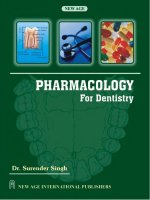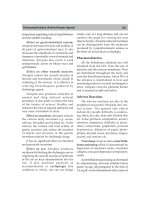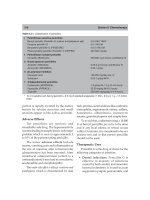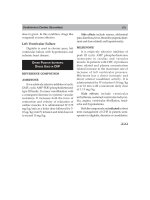Pharmacology for dentistry phần 63
Bạn đang xem bản rút gọn của tài liệu. Xem và tải ngay bản đầy đủ của tài liệu tại đây (45.24 KB, 5 trang )
Section 8/ Drugs Acting on Endocrine System
298
coloured pills starting from fifth day of
menstrual cycle to twenty-fifth day and next
pack can be started after a gap of seven days
as in case of combined pills.
MINIPILL
It is also known as progestin only pill
(POP). It contains only progestins, which is
given in small amount throughout the menstrual cycle (without interruption) but because
of lower efficacy rate, it is not much popular.
Norgestrel (OVRETTE)
0.075 mg
Norethindrone (MICRONOR)
0.35 mg
POSTCOITAL CONTRACEPTION
The postcoital (morning after)
contraception is recommended within 48
hours after an unprotected intercourse, rape
or contraceptive failure.
Diethylstilbestrol 5 mg per day is given
for five days.
Other regimens used are combination of
ethinyl estradiol 0.1 mg + levonorgestrel 0.5 to
1 mg. Two tablets are taken 12 hours apart
within three days of intercourse. Levonorgestrel
0.75 mg (1 tablet) is also used and is taken as
early as possible (within 72 hrs) and second
tablet after 12-24 hours of first tablet.
Withdrawal bleeding occur within 3-7 days.
INJECTABLE FORMULATIONS
They are usually given by IM route. They
lead to higher incidence of menstrual
irregularities and amenorrhoea.
• Norethindrone
enanthate
(NORISTERAT) 200 mg given once in
two months.
• Depot medroxyprogesterone acetate
(DEPOT PROVERA) 150 mg given once
in 3 month and 400 mg given once in 6
month.
Some subcutaneous and intrauterine
implants of progesterone have also been
used which are prepared in biodegradable
polymeric matrices.
Mechanism of Action of Oral
Contraceptives
The oral contraceptives act by the different mechanisms.
• Inhibiting ovulation by blocking the
release of follicle stimulating hormone
and luteinising hormone from the
anterior lobe of pituitary gland.
• Increasing the thickness of cervical
mucus due to progestins and producing
an unfavourable environment for penetration of sperm and further conception.
• Inducing other changes in the uterine
mucosa which may be unfavourable for
the implantation of fertilized ovum.
This action is important in minipills
and postcoital pills.
Adverse Effects
The most common side effects are nausea,
vomiting, headache, dizziness, fatigue, weight
gain and breast fullness. The other side effects
which appear after sometime of therapy are
acne, increased body hair, pigmentation of
cheeks, nose and forehead (chloasma).
The other serious side effects include
high blood pressure, increased risk of myocardial infarction, thromboembolic diseases like thrombophlebitis, venous thrombosis, cerebral thrombosis.
They were suspected to lead to increased
risk of cancer of breast and carcinoma of
cervix and endometrium.
Hormonal Contraceptives
CENTCHROMAN
Its a nonsteroidal estrogen antagonist,
which acts by preventing implantation due
to embryouterine asynchrony, accelerated
tubal transport and suppression of
decidualization. It has no effect on pituitary
or ovarian functions. It is taken 30 mg twice
weekly for 12 weeks followed by once a
week as long as fertility is to be suppressed.
MALE CONTRACEPTIVE
The main research focus is different
approaches e.g. agent which prevent spermatogenesis, interfering with sperm stor-
299
age and maturation and preventing sperm
transport in vas deferens. But the
hormones which suppress sperm production tend to lower testosterone and affect
the potency and libido.
The one product obtained from cottonseed oil, Gossypol which is categorized as
non-hormonal selective spermatogenesis
suppressant, is effective in producing
azoospermia or severe oligospermia but it
is not widely used as male contraceptive.
Mechanism of action is not known. Adverse
effects are edema, diarrhoea, hypokalemia,
neuritis.
This page
intentionally left
blank
Section 9
Chemotherapy
This page
intentionally left
blank









